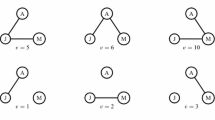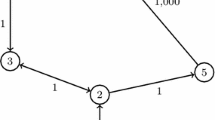Abstract
The models of network active systems are introduced and studied. A network active system consists of a finite set of agents interacting within a given network; each agent is characterized by the technology of his activity (a dependence of the output on his own action and also the outputs of other agents). The problems of incentives and planning are stated and solved. Applications of network active systems for the modeling and optimization of extended enterprises are discussed.
Similar content being viewed by others
References
Belov, M.V. and Novikov, D.A., Metodologiya kompleksnoi deyatel’nosti (Methodology of Complex Activity), Moscow: Lenand, 2018.
Jackson, M.O., Social and Economic Networks, Princeton: Princeton Univ. Press, 2010.
The Oxford Handbook of the Economics of Networks, Oxford: Oxford Univ. Press, 2016.
Burkov, V.N., Gorgidze, I.A., and Lovetskii, S.E., Prikladnye zadachi teorii grafov (Applied Problems of Graph Theory), Tbilisi: Vychisl. Tsentr Akad. Nauk GSSR, 1974.
Golenko-Ginzburg, D.I., Stokhasticheskie setevye modeli planirovaniya i upravleniya razrahotkami (Stochastic Network Models of R&D Planning and Management), Voronezh: Nauchnaya Kniga, 2010.
Matematicheskie osnovy upravleniya proektami (Mathematical Foundations of Project Management), Burkov, V.N., Ed., Moscow: Vysshaya Shkola, 2005.
Mechanism Design and Management: Mathematical Methods for Smart Organizations, Novikov, D.A., Ed., New York: Nova Science, 2013.
Belov, M.V., Modern Organization and Management of Production Programs: Current State and Development Trends, Upravlen. Proekt. Program., 2015, no. 2, pp. 86–99.
Novikov, D.A., Theory of Control in Organizations, Hauppauge: Nova Science, 2013.
Novikov, D.A., Setevye struktury i organizatsionnye sistemy (Network Structures and Organizational Systems), Moscow: Inst. Probl. Upravlen., 2003.
Novikov, D.A. and Tsvetkov, A.V., Mekhanizmy stimulirovaniya v mnogoelementnykh organizatsionnykh sistemakh (Incentive Mechanisms in Multiagent Organizational Systems), Moscow: Apostrof, 2000.
Myerson, R.B., Game Theory: Analysis of Conflict, London: Harvard Univ. Press, 1997.
Kupferman, O. and Tamir, T., Hierarchical Network Formation Games, in Tools and Algorithms for the Construction and Analysis of Systems, TACAS 2017, Legay, A. and Margaria, T., Eds., Lecture Notes in Computer Science, vol. 10205, Berlin: Springer, 2017, pp. 229–246.
Germeier, Yu.B., Non-Antagonistic Games, Dordrecht: D. Reidel, 1986.
Burkov, V.N., Korgin, N.A., and Novikov, D.A., Integration and Decomposition Problems of Control Mechanisms for Organizational and Technical Systems, Probl. Upravlen., 2016, no. 5, pp. 14–23.
Voronin, A.A. and Kharitonov, M.A., Adaptation Model for Operating Core of Organization, Vestn. Volg. Gos. Univ., Ser. 1, Mat. Fiz., 2016, no. 4, pp. 44–65.
Voronin, A.A. and Kharitonov, M.A., Constrained Optimization Model of Organization’s Operating Core, Upravlen. Bol’sh. Sist., 2012, no. 39, pp. 165–183.
Goubko, M.V., Matematicheskie modeli optimizatsii ierarkhicheskikh struktur (Mathematical Methods of Optimization of Hierarchical Structures), Moscow: LENAND, 2006.
Mishin, S.P., Optimal’nye ierarkhii upravleniya v ekonomicheskikh sistemakh (Optimal Control Hierarchies in Economic Systems), Moscow: PMSOFT, 2004.
Acknowledgments
This work was supported in part by the Russian Science Foundation, project no. 16-19-10609.
Author information
Authors and Affiliations
Corresponding authors
Additional information
Russian Text © The Author(s), 2018, published in Problemy Upravleniya, 2018, No. 1, pp. 7–57.
Rights and permissions
About this article
Cite this article
Belov, M.V., Novikov, D.A. Network Active Systems: Models of Planning and Incentives. Autom Remote Control 80, 2229–2244 (2019). https://doi.org/10.1134/S0005117919120117
Received:
Revised:
Accepted:
Published:
Issue Date:
DOI: https://doi.org/10.1134/S0005117919120117




